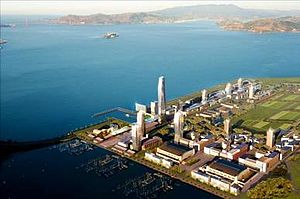Treasure Island Development facts for kids
The Treasure Island Development is a huge building project happening on Treasure Island and parts of Yerba Buena Island in San Francisco Bay. These islands are located between the cities of San Francisco and Oakland. The project aims to transform the former naval base into a new community. It's a big plan that will cost about $1.5 billion.
This development is being managed by a group called the Treasure Island Development Authority (TIDA). The project was supposed to start in 2012, but there were some delays. Now, a partnership between Lennar Corporation and Kenwood Investments is working on it.
Contents
What is the Treasure Island Development Authority?
The Treasure Island Development Authority (TIDA) is a special city group that helps manage the building and growth of Treasure Island. It's a nonprofit organization, which means it works for the public good, not to make money.
TIDA has a group of seven leaders called a Board of Directors. These leaders were chosen by the former Mayor of San Francisco, Ed Lee. Their main job is to make sure the island is developed in a way that is good for the environment and also helps the economy. They also create the main plan for how the island will look and work.
TIDA wants to achieve several important goals:
- Being a leader in protecting the environment.
- Making the island a popular place for visitors.
- Creating a unique neighborhood in San Francisco.
- Bringing benefits and job opportunities to the community.
The Big Plan for Treasure Island
The main plan for Treasure Island is to create a new, modern community. Here are some of the exciting ideas:
- All homes will be close to shops and services, so you can walk to everything you need in about 10 minutes.
- A new ferry station will connect to a shopping area. This area will be the heart of the new community, with a tall 40-story building and hotels.
- There will be three different neighborhoods with various types of homes, like townhouses and apartments. Some buildings will be as tall as 14 stories.
- The plan also includes five very tall towers, a school for kids from kindergarten to 8th grade, and many shops and offices (about 450,000 square feet).
- There will be a huge park (275 acres) and a 20-acre organic farm where food can be grown naturally.
- A marina for 400 boats and a beach are also planned, along with modern community centers.
This whole project is expected to take a long time to build, possibly 20 to 30 years. Once finished, it will create 8,000 new homes for about 20,000 people.
Tall Buildings Planned
The development will include several tall buildings. Here are some of the tallest ones planned:
| Name | Floors |
|---|---|
| Sun Tower | 60 |
| Treasure Island Tower I | 40 |
| Treasure Island Tower II | 40 |
| Treasure Island Tower III | 40 |
| Treasure Island Tower IV | 40 |
How the Project is Going
The city of San Francisco has been working on redeveloping Treasure Island since the U.S. Navy closed its base there in 1997. The project is being built by a partnership between Lennar Corporation and Kenwood Investments.
In 2011, the San Francisco Board of Supervisors (city leaders) fully approved the project. City officials are now working with the U.S. Navy to transfer the land. This project is expected to create 3,000 permanent jobs and 2,000 construction jobs.
Currently, about 1,800 people live on Treasure and Yerba Islands. They have access to shops, restaurants, schools, and sports clubs. Construction for this big development started in March 2016.
Concerns About the Project
Some people have concerns about the Treasure Island project.
- One worry is that the island's soil might have harmful substances from its past use.
- Another concern is that the land could sink or become unstable during an earthquake. This is because the ground is prone to subsidence (sinking) and liquefaction (when soil acts like a liquid during shaking).
After the city approved the project in 2011, a group called "Citizens for a Sustainable Treasure Island" filed a lawsuit. They were worried that the project's effects on the environment and traffic had not been properly studied. However, the courts did not agree with their complaint, and the case was closed in 2014.


